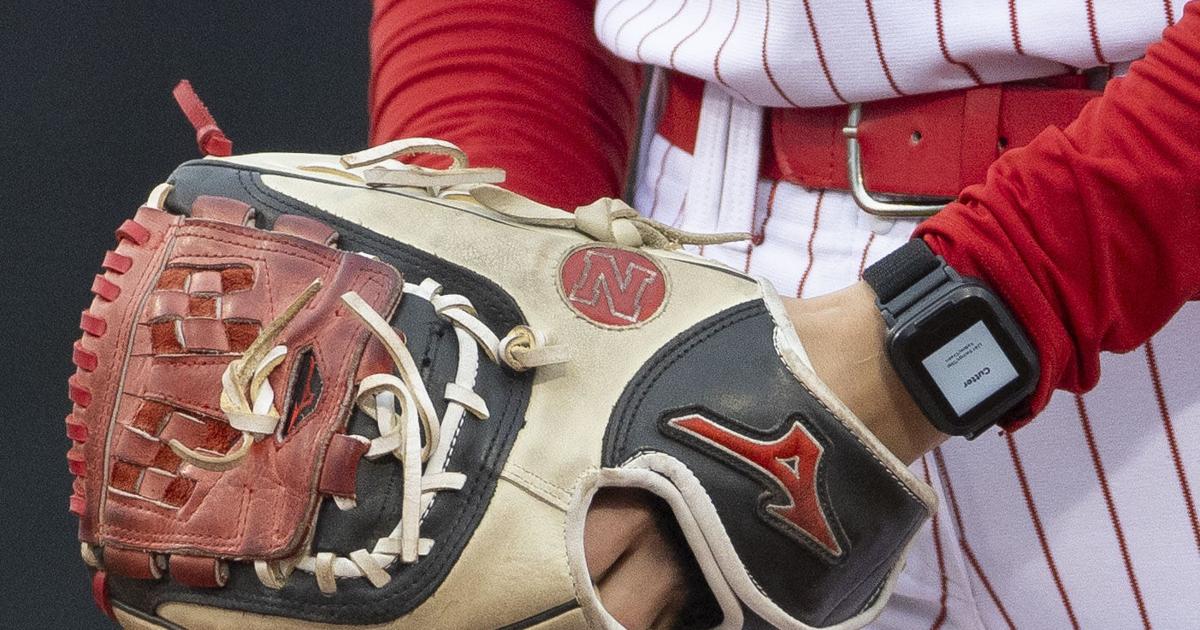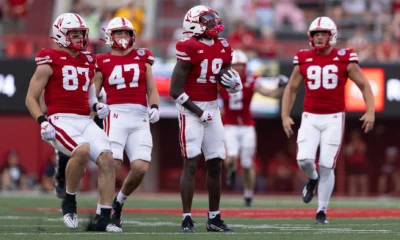
Between every pitch, Nebraska’s softball players look away from the field and toward their wrists.
No, they’re not checking the time or their messages — the smartwatch is used for a much different purpose. Starting this season, the Nebraska softball team partnered with GoRout to implement an electronic communication device that allows coaches to deliver signals quicker than ever before.
“It’s been really nice,” Nebraska head coach Rhonda Revelle said. “We’re able to personalize it for each pitcher’s pitches and we can also put words on it like, ‘Keep it low’ or some meaningful instruction. It’s also nice that we can position the infielders and outfielders in their starting spot.”
It was a long, multi-year process to reach this point.
Traditionally, pitch calls in baseball and softball are communicated from the dugout to the catcher, then to the pitcher using signs or signals. For decades, that meant a cat-and-mouse game between opposing teams.
People are also reading…
Runners on base would try to identify a catcher’s signs and then tip their teammates off about what pitch would be coming. To defend against the possibility of an opponent deciphering signals, teams would change them early and often to keep their foes guessing.
There was surely an easier way for calls to be relayed from the dugout to a pitcher, and a handful of companies across the country were racing to find the solution.
The process began in 2017 to 2019 on a small trial basis when the NCAA granted several waivers for college baseball teams to use electronic communication devices in fall exhibition contests. Early trials were akin to how an NFL coach would deliver a play call to a quarterback through their helmet — a one-way, audio communication device used to deliver a pitch call to the catcher instead.
The early technology was bulky and often worked inconsistently. Soon, another vision emerged — what if it was possible to have a wearable device that could receive a secure electronic signal from the bench? And thus the electronic wristband began its journey into collegiate athletics.
In terms of the type of connection that could be used with the devices, Bluetooth signals’ lack of security and limited range posed a challenge, while radio signals could be encrypted but lacked the widespread application needed to communicate with the entire team.
The solution for Nebraska came through GoRout, which uses cellular signals to communicate between the dugout and the field.
Mandie Nocita, Nebraska softball’s director of video technology, analytics and player development, set up the system shortly before the 2024 season began. Using the company-issued tablet that cannot receive any data per NCAA rules, opposing lineups and scouting reports are loaded into the system before the game.
Revelle calls the pitches in the dugout, the input is quickly keyed on the tablet, then the players’ watches show the instruction.
“There’s about a two-second delay for them to get the signal, but it’s been handy and we’re big fans of it,” Nocita said. “Like any technology, there are times when it does glitch (because) it’s not perfect, but it’s been working really well for us.”
If the technology were to fail or glitch during the game, NU would revert back to the old-school method of delivering pitch calls.
The use of such devices became official in August 2021, when the NCAA Playing Rules Oversight Panel approved the use of one-way electronic communication devices in college baseball and softball. Several baseball programs quickly implemented the technology, while the NCAA Softball Rules Committee did not fully approve the change until before the 2024 season.
Alongside pitch clocks, electronic communication devices are used to help speed up the game. With a 20-second pitch clock in softball, the time it takes to quickly glance at the watch and go to the plate is negligible for the pitcher.
“The only problem is that if you want to shake off a pitch it can take some time, but typically our pitchers are getting their signal with 12 seconds to spare, so they have plenty of time,” Revelle said.
The success of such communication devices is enormously relevant as the NCAA mulls changes to how football implements technology. News of Michigan football’s widespread sign-stealing operation rocked the sport in the fall, with Nebraska head coach Matt Rhule eventually saying that coaches should be able to communicate through helmets like in the NFL.
“You can get rid of all the stupid signs on the sidelines and the pictures of rock stars and all that stuff, and just play football,” Rhule said in October 2023. “You go to a high school game, there’s technology on the sideline. You go to an NFL game, there’s technology on the sideline. You go to college, there’s nothing.”
Rhule’s not the only one who feels that way. Coaches and administrators in the nation’s two mega-conferences — the Big Ten and the SEC — put the pressure on the NCAA this offseason. And on March 1, the NCAA Football Rules Committee paved the way for it to happen.
The committee delivered a recommendation that FBS schools would be able to “use coach-to-player communications through the helmet to one player on the field.” Much like in the NFL, the audio connection would turn off with 15 seconds left on the play clock or when the ball is snapped.
Nothing is certain yet — the NCAA Playing Rules Oversight Panel will still need to approve the proposal during its April 18 meeting — but college football is closer to implementing technology than ever before.
Based on the ease of operations and the tangible benefits the Nebraska softball team has already felt with its own electronic communication system, it may be sooner rather than later that a similar setup arrives in other sports.
Photos: Nebraska softball hosts Northern Colorado, March 14
Nebraska fans Heath Campbell (left) and his wife Morgan bundle up under blankets to watch the game against Northern Colorado on Thursday, March 14, 2024, at Haymarket Park.
KATY COWELL Journal Star

Nebraska’s Ava Bredwell (24) celebrates a double during the fourth inning of the game against Northern Colorado on Thursday, March 14, 2024, at Haymarket Park.
KATY COWELL Journal Star

Nebraska’s Billie Andrews (6) throws to first base during the first inning of the game against Northern Colorado on Thursday, March 14, 2024, at Haymarket Park.
KATY COWELL Journal Star

Nebraska’s Caitlin Olensky (22) looks down at a pitch communication device on her wrist during the game against Northern Colorado on Thursday, March 14, 2024, at Haymarket Park.
KATY COWELL Journal Star

Nebraska’s Mckinley Malecha (0) extends her arm to catch a foul ball for an out during the fifth inning of the game against Northern Colorado on Thursday, March 14, 2024, at Haymarket Park.
KATY COWELL Journal Star

Nebraska’s Sarah Harness (2) wears a pitch communication device on her wrist during the game against Northern Colorado on Thursday at Bowlin Stadium.
KATY COWELL, Journal Star

Nebraska’s Billie Andrews (6) and Nebraska’s Katelyn Caneda (66) celebrate an out during the fourth inning of the game against Northern Colorado on Thursday, March 14, 2024, at Haymarket Park.
KATY COWELL Journal Star

Nebraska’s Sarah Harness (2) glances down at the pitch communication device on her wrist during the game against Northern Colorado on Thursday, March 14, 2024, at Haymarket Park.
KATY COWELL Journal Star

Nebraska’s Sarah Harness (2) wears a pitch communication device on her wrist during the game against Northern Colorado on Thursday, March 14, 2024, at Haymarket Park.
KATY COWELL Journal Star

Nebraska’s Katelyn Caneda (66) attempts to tag out Northern Colorado’s Alison Steinker (4) during the first inning of the game on Thursday, March 14, 2024, at Haymarket Park.
KATY COWELL Journal Star

Nebraska’s Mckinley Malecha (0) celebrates catching a foul ball to end the fifth inning of the game against Northern Colorado on Thursday, March 14, 2024, at Haymarket Park.
KATY COWELL Journal Star

Nebraska’s Billie Andrews (6) watches the ball go by her as she bats during the fifth inning of the game on Thursday, March 14, 2024, at Haymarket Park.
KATY COWELL Journal Star

Nebraska’s Billie Andrews (6) attempts to tag out Northern Colorado’s Ella Gonzales (13) during the second inning of the game on Thursday, March 14, 2024, at Haymarket Park.
KATY COWELL Journal Star

Nebraska’s Billie Andrews (6) holds her glove in the air to show she had the ball after the runner didn’t tag up at second base to give the Huskers an out during the fifth inning of the game against Northern Colorado on Thursday, March 14, 2024, at Haymarket Park.
KATY COWELL Journal Star

Must See
-


Football
/ 5 months agoHuskers Fight Hard but Fall Short Against UCLA
LINCOLN – The Nebraska Cornhuskers gave it their all on Saturday, with standout efforts...
-


Football
/ 5 months agoGAMEDAY: Nebraska Set to Face Undefeated Indiana in Key Big Ten Showdown
Bloomington, IN – It’s Game Day, Husker Nation! Nebraska (5-1, 2-1 Big Ten) returns...
-


Football
/ 5 months agoBlackshirts Shine as Nebraska Tops Rutgers 14-7 on Homecoming
Lincoln, NE – Nebraska’s Blackshirt defense played a starring role in the Huskers’ 14-7...
By Chris














You must be logged in to post a comment Login